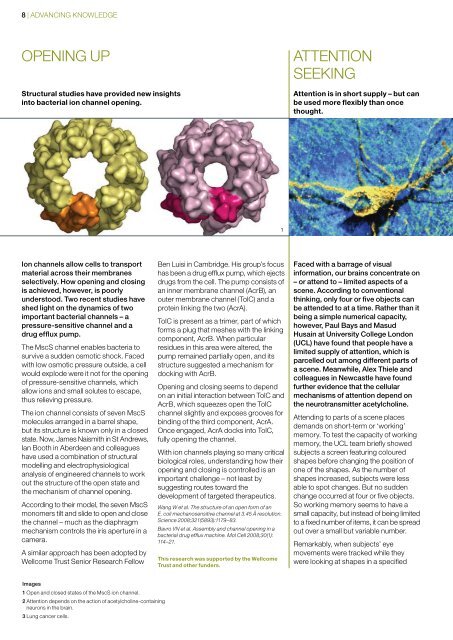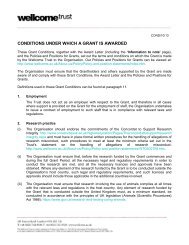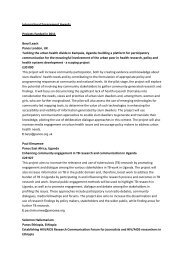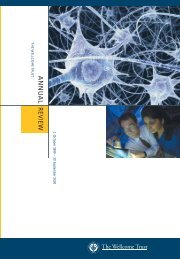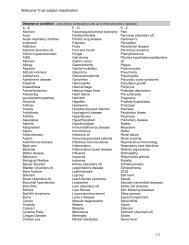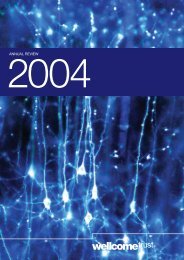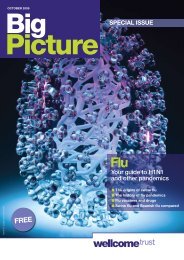Create successful ePaper yourself
Turn your PDF publications into a flip-book with our unique Google optimized e-Paper software.
8 | advancing Knowledge<br />
Opening up<br />
Structural studies have provided new insights<br />
into bacterial ion channel opening.<br />
Attention<br />
seeking<br />
Attention is in short supply – but can<br />
be used more flexibly than once<br />
thought.<br />
1<br />
Ion channels allow cells to transport<br />
material across their membranes<br />
selectively. How opening and closing<br />
is achieved, however, is poorly<br />
understood. Two recent studies have<br />
shed light on the dynamics of two<br />
important bacterial channels – a<br />
pressure-sensitive channel and a<br />
drug efflux pump.<br />
The MscS channel enables bacteria to<br />
survive a sudden osmotic shock. Faced<br />
with low osmotic pressure outside, a cell<br />
would explode were it not for the opening<br />
of pressure-sensitive channels, which<br />
allow ions and small solutes to escape,<br />
thus relieving pressure.<br />
The ion channel consists of seven MscS<br />
molecules arranged in a barrel shape,<br />
but its structure is known only in a closed<br />
state. Now, James Naismith in St Andrews,<br />
Ian Booth in Aberdeen and colleagues<br />
have used a combination of structural<br />
modelling and electrophysiological<br />
analysis of engineered channels to work<br />
out the structure of the open state and<br />
the mechanism of channel opening.<br />
According to their model, the seven MscS<br />
monomers tilt and slide to open and close<br />
the channel – much as the diaphragm<br />
mechanism controls the iris aperture in a<br />
camera.<br />
A similar approach has been adopted by<br />
<strong>Wellcome</strong> <strong>Trust</strong> Senior Research Fellow<br />
Ben Luisi in Cambridge. His group’s focus<br />
has been a drug efflux pump, which ejects<br />
drugs from the cell. The pump consists of<br />
an inner membrane channel (AcrB), an<br />
outer membrane channel (TolC) and a<br />
protein linking the two (AcrA).<br />
TolC is present as a trimer, part of which<br />
forms a plug that meshes with the linking<br />
component, AcrB. When particular<br />
residues in this area were altered, the<br />
pump remained partially open, and its<br />
structure suggested a mechanism for<br />
docking with AcrB.<br />
Opening and closing seems to depend<br />
on an initial interaction between TolC and<br />
AcrB, which squeezes open the TolC<br />
channel slightly and exposes grooves for<br />
binding of the third component, AcrA.<br />
Once engaged, AcrA docks into TolC,<br />
fully opening the channel.<br />
With ion channels playing so many critical<br />
biological roles, understanding how their<br />
opening and closing is controlled is an<br />
important challenge – not least by<br />
suggesting routes toward the<br />
development of targeted therapeutics.<br />
Wang W et al. The structure of an open form of an<br />
E. coli mechanosensitive channel at 3.45 Å resolution.<br />
Science 2008;321(5893):1179–83.<br />
Bavro VN et al. Assembly and channel opening in a<br />
bacterial drug efflux machine. Mol Cell 2008;30(1):<br />
114–21.<br />
This research was supported by the <strong>Wellcome</strong><br />
<strong>Trust</strong> and other funders.<br />
Faced with a barrage of visual<br />
information, our brains concentrate on<br />
– or attend to – limited aspects of a<br />
scene. According to conventional<br />
thinking, only four or five objects can<br />
be attended to at a time. Rather than it<br />
being a simple numerical capacity,<br />
however, Paul Bays and Masud<br />
Husain at University College London<br />
(UCL) have found that people have a<br />
limited supply of attention, which is<br />
parcelled out among different parts of<br />
a scene. Meanwhile, Alex Thiele and<br />
colleagues in Newcastle have found<br />
further evidence that the cellular<br />
mechanisms of attention depend on<br />
the neurotransmitter acetylcholine.<br />
Attending to parts of a scene places<br />
demands on short-term or ‘working’<br />
memory. To test the capacity of working<br />
memory, the UCL team briefly showed<br />
subjects a screen featuring coloured<br />
shapes before changing the position of<br />
one of the shapes. As the number of<br />
shapes increased, subjects were less<br />
able to spot changes. But no sudden<br />
change occurred at four or five objects.<br />
So working memory seems to have a<br />
small capacity, but instead of being limited<br />
to a fixed number of items, it can be spread<br />
out over a small but variable number.<br />
Remarkably, when subjects’ eye<br />
movements were tracked while they<br />
were looking at shapes in a specified<br />
Images<br />
1 Open and closed states of the MscS ion channel.<br />
2 Attention depends on the action of acetylcholine-containing<br />
neurons in the brain.<br />
3 Lung cancer cells.


